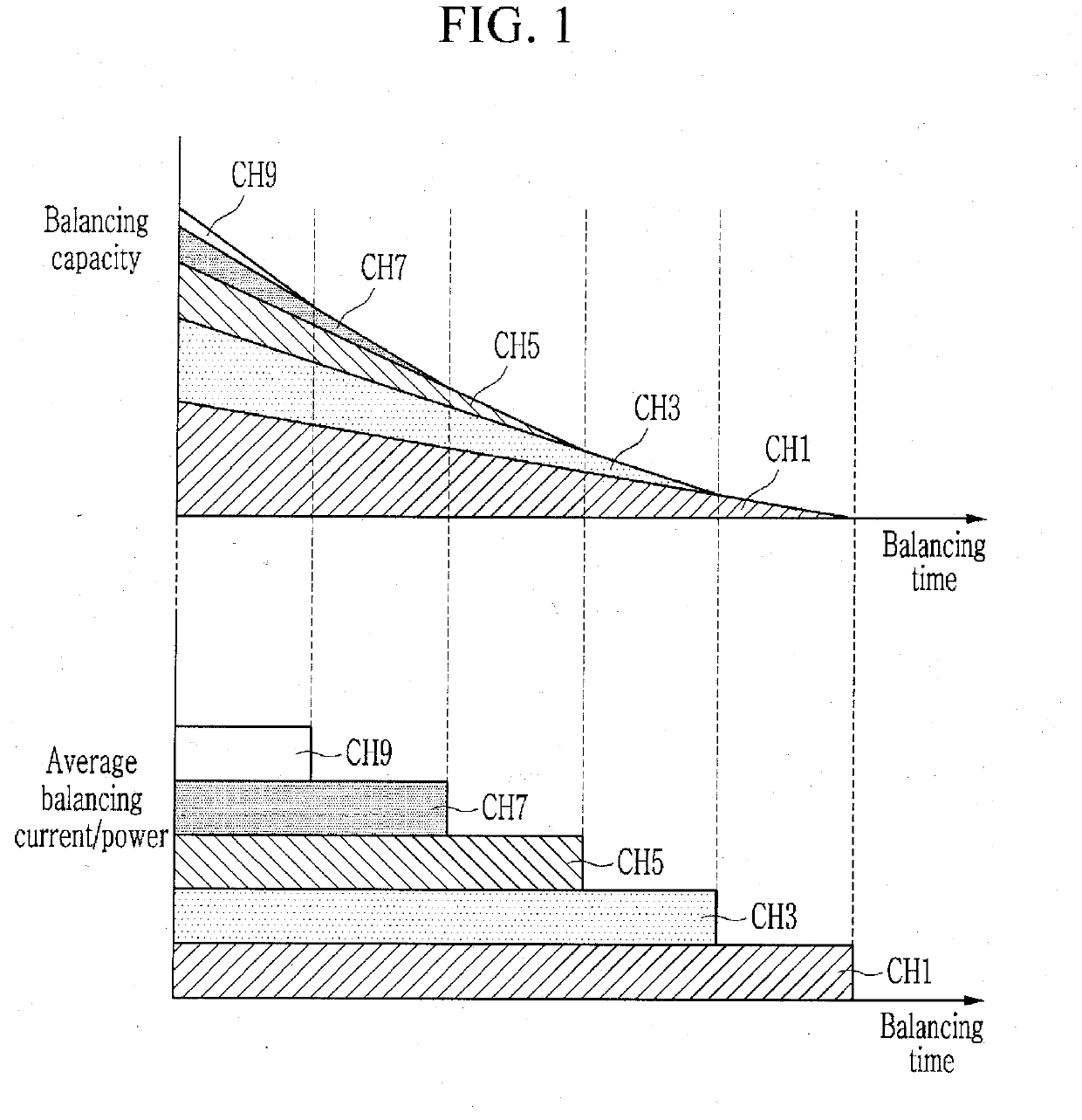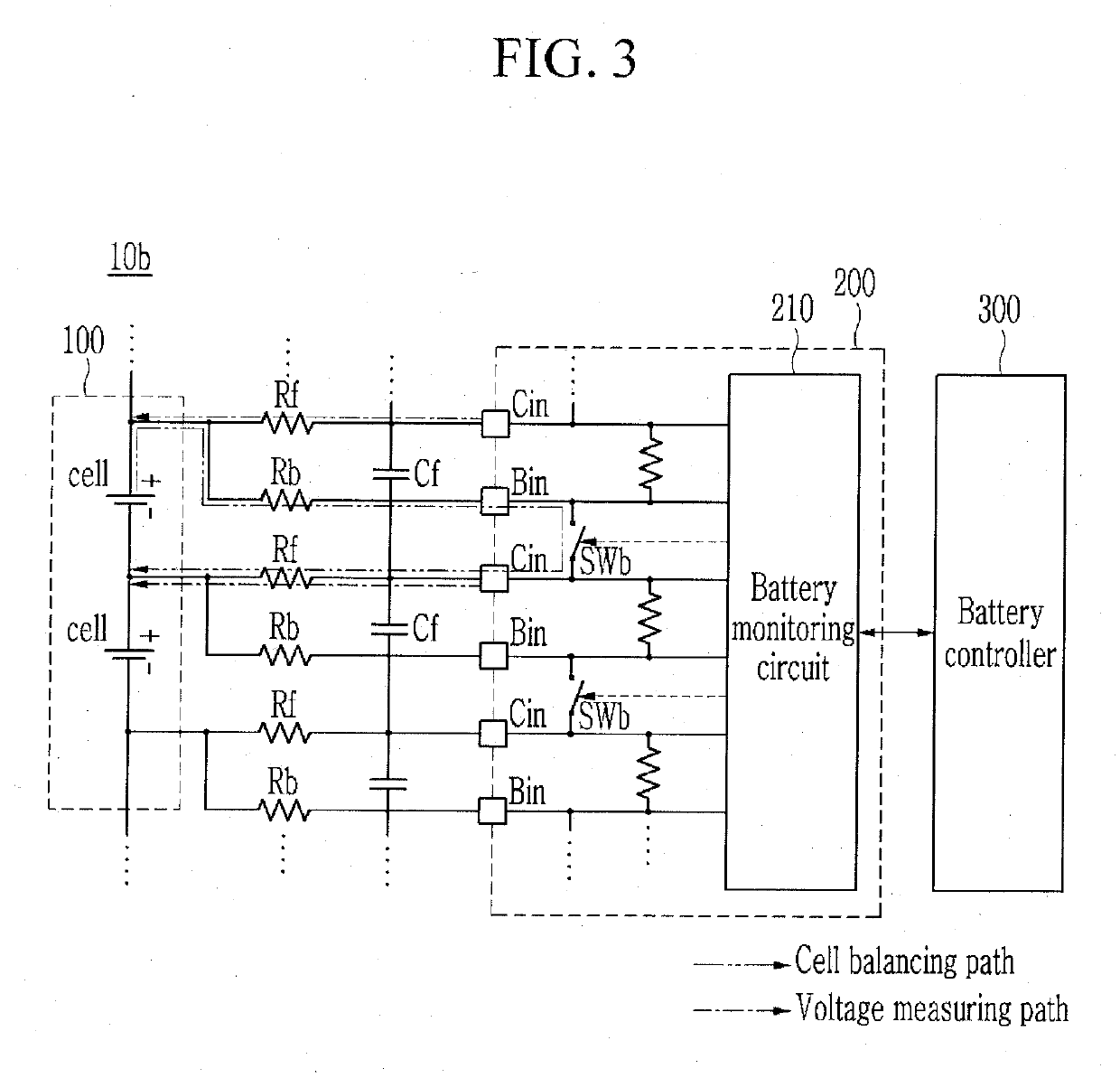Cell-balancing method and battery management system performing the same
a cell-balancing and management system technology, applied in battery/fuel cell control arrangement, secondary cell servicing/maintenance, instruments, etc., can solve the problems of complex control, energy consumption of discharging, radiation of heat, etc., and achieve the effect of reducing the balancing tim
- Summary
- Abstract
- Description
- Claims
- Application Information
AI Technical Summary
Benefits of technology
Problems solved by technology
Method used
Image
Examples
first embodiment
[0094]A cell-balancing method according to the present disclosure will now be described with reference to FIG. 6 to FIG. 8.
[0095]FIG. 6 shows a cell-balancing method according to a first embodiment of the present disclosure. FIG. 7 and FIG. 8 show examples of balancing capacity and a changing trend of average balancing current / power when a cell-balancing control method according to a first embodiment of the present disclosure is used. FIG. 9 shows an example of a related art cell-balancing control timing diagram, and FIG. 10 shows an example of a cell-balancing control timing diagram when a cell-balancing method according to a first embodiment of the present disclosure is applied.
[0096]Referring to FIG. 6, according to a first embodiment of the present disclosure, the battery packs 10a, 10b, and 10c periodically detect a cell voltage of each cell configuring the battery module 100 through the battery IC 200 (S100).
[0097]In S100, the battery IC 200 includes a voltage-detecting circui...
second embodiment
[0123]To solve the above-noted problem, in the cell-balancing method according to the present disclosure, while the duty cycle of the balancing switches (SWb) is based on-the balancing capacity ratio among the balancing target cells, the duty cycle of the balancing switches (SWb) is scaled so that sums of duty cycles of the two adjacent cells may be less than or equal to a maximum of 100%. Therefore, one balancing on one of two adjacent cells is turned on while the balancing of the other is turned off to prevent two adjacent cells from simultaneously being turned on. Accordingly, it becomes possible to set the duty cycle of one cell to be greater than 50% through a duty scaling, thereby increasing the cell-balancing efficiency.
[0124]A cell-balancing method according to a second embodiment of the present disclosure will now be described in detail with reference to FIG. 11 to FIG. 14.
[0125]FIG. 11 shows a cell-balancing method according to a second embodiment of the present disclosure...
third embodiment
[0156]To solve the issue of heat generation, a cell-balancing method according to the present disclosure described below may acquire the heat radiation performance of the substrate on which a cell-balancing circuit is located by managing power consumption of all of the balancing resistors in addition to individual power consumption of each balancing resistor.
[0157]Power generated by the balancing current generates heat by the balancing resistor, and the heat generated by the balancing resistor is mostly radiated through a wiring pattern of the substrate according to a thermal conduction method. Therefore, the configuration of the substrate provided around the balancing resistor or the wiring pattern may influence the heat radiation performance. The balancing resistors are close to each other on the actual substrate. Hence, the heat radiation performance of the substrate may be obtained by managing the power consumption of the balancing resistors in addition to individual power consu...
PUM
 Login to View More
Login to View More Abstract
Description
Claims
Application Information
 Login to View More
Login to View More - R&D
- Intellectual Property
- Life Sciences
- Materials
- Tech Scout
- Unparalleled Data Quality
- Higher Quality Content
- 60% Fewer Hallucinations
Browse by: Latest US Patents, China's latest patents, Technical Efficacy Thesaurus, Application Domain, Technology Topic, Popular Technical Reports.
© 2025 PatSnap. All rights reserved.Legal|Privacy policy|Modern Slavery Act Transparency Statement|Sitemap|About US| Contact US: help@patsnap.com



